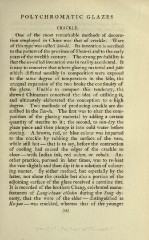Page 421 - Oriental Series Japan and China, Brinkly
P. 421
POLYCHROMATIC GLAZES
CRACKLE.
One of the most remarkable methods of decora-
tion employed in China was that of crackle. Ware
of this type was called Sui-ki. Its invention is ascribed
to the potters of the province of Shen-si and to the early
years of'the twelfth century. The strong probability is
that the so-called invention was in reality accidental. It
is easy to conceive that where glazing material and pate
which differed sensibly in composition were exposed
to the same degree of temperature in the kiln, the
unequal expansion of the two broke the continuity of
the glaze. Unable to conquer this tendency, the
shrewd Chinaman conceived the idea of utilising it,
and ultimately elaborated the conception to a high
degree. Two methods of producing crackle are de-
scribed in the Tao-lu. The first was to alter the com-
position of the glazing material by adding a certain
quantity of steatite to it the second, to sun-dry the
;
glaze piece and then plunge it into cold water before
Astoving.
brown, red, or blue colour was imparted
to the crackle by rubbing the surface of the vase,
while still hot that is to say, before the contraction
of cooling had caused the edges of the crackle to
close with Indian ink, red ochre, or cobalt. An-
other practice, pursued in later times, was to re-heat
the vase slightly and then dip it in a solution of colour-
ing matter. By either method, but especially by the
latter, not alone the crackle but also a portion of the
adjoining surface of the glaze received a carmine tint.
It is recorded of the brothers Chang, celebrated manu-
facturers of Lung-chuan celadon during the Sung dy-
nasty, that the ware of the elder distinguished as
Ko-yao was crackled, whereas that of the younger
343

